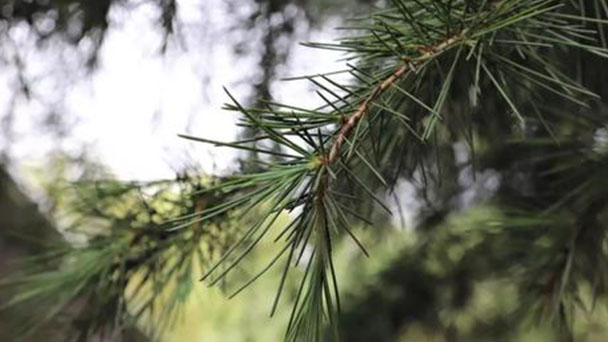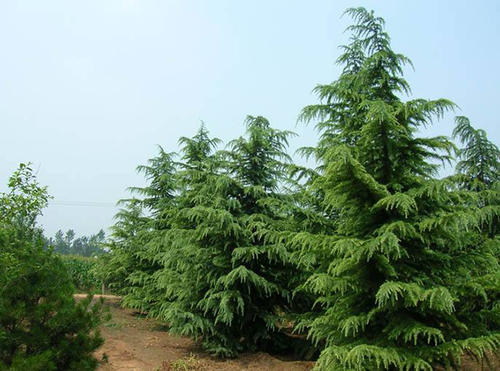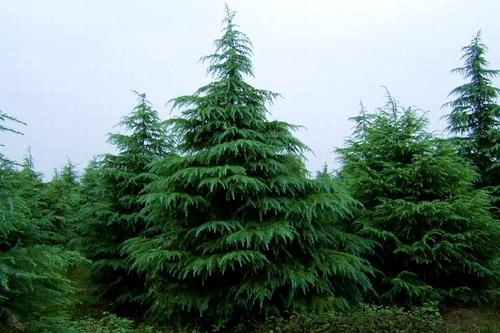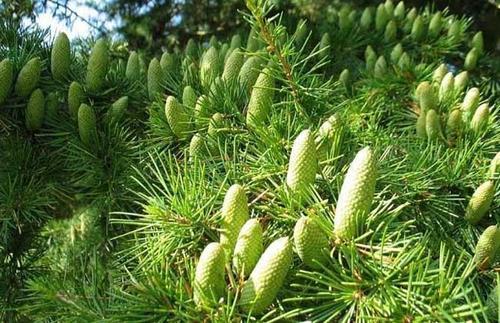Deodar Cedar (Cedrus deodara) Profile
Written by Maggie
Sep 18 2021

Deodar cedar (Cedrus deodara) is a plant of the genus Deodar cedar in the pine family. Deodar cedar is an evergreen tree with a pine-shaped crown with large spreading branches and slightly pendulous branchlets. Leaves Are needle-shaped, 8-60 cm long, hard, grayish green or silvery gray, scattered on long branches, clustered on short branches. Cones mature next year, elliptical ovate, ripe when russet.
Deodar cedar picture

Deodar cedar info
| Botanical Name | Cedrus deodara |
| Common Names | Deodar Cedar, Himalayan Cedar |
| Plant Type | Evergreen coniferous tree |
| Sun | Full sun |
| Hardiness Zones | 7 to 9 (USDA) |
| Flower color | Non-flowering |
| Native Area | Western Himalayas |
| Mature size | 40 to 70 feet tall, 20 to 40 feet wide |
Morphological characteristics of deodar cedar
Deodar cedar is about 30 m high, up to 3 m at breast diameter; Bark is dark gray, divided into irregular scales; Branches are flat, slightly inclined exhibition or slightly drooping, the base of persistent bud scales to the outward inverse curvature, twigs often droop, one-year long branches pale gray yellow, dense short villi, micro white powder, two, three years of branches were gray, light brown gray or dark gray.
Deodar cedar branches radiation, extend the lobe of short shoot clusters form (about 15-20) every year bring forth new leaves, leaf needle, hard, light green or dark green, 2.5 5 cm long, 1-1.5 mm wide, upper wide, apex lancet, lower gradually narrow, often into three rhombus, thin back, leaves on both sides of the front of each have 2-3 stomatal lines, on the back of the 4-6, stomatal lines at a young age with white powder. Male cones of deodar cedar are ovoid or ellipsoid-ovoid, 2 -- 3 cm long, ca. 1 cm in diameter; The female cones are ovoid, ca. 8 mm long and 5 mm in diameter.
Cones of Deodar cedar are pale green before maturity, slightly pinkish white, reddish brown when ripe, ovoid or broadly elliptic, 7-12 cm long, 5-9 cm in diameter, blunt round tip, short peduncle; Middle species scales fan-shaped triangular, 2.5-4 cm long, 4-6 cm wide, upper part broadly rounded, margin inwardly curved, middle wedge-shaped, lower auriculate, base clawlike, scale back densely short villi; Bract scales are short; Seeds are sub triangular, winged wider, longer than seeds, with seeds 2.2-3.7 cm long.
Deodar cedar is an original evergreen large tree, 60-80 m high, 3-4.5 m diameter at breast height. The trunk end is straight, irregular whorls of large branches, flat, branchlet emblem drooping, lower branches close to the ground asked, forming a tower-shaped crown, brown bark, smooth when young, after the old age is cracked for scaly peeling. Leaves are needle-shaped, bluish-green, 2.5-5 cm long.Apex closed, spirally scattered on long branches, dioecious on short branches, rarely monomorphous, cone solitary branch apex. The female cones are purplish red at first, then pale green; Male cones of Deodar cedar are yellow.
The crown of Deodar cedar is conical, graceful, the trunk is straight, the old branches are scattered, and the twig tip is drooping. Deodar cedar is an evergreen tree, large branches generally flat, irregular whorls, slightly pendulous branchlets. Bark is grayish brown, cracked into scales, peeling off when old. Leaves are spirally scattered on long branches, clustered on short branches.Leaves aciculate, qualitative hard, apex pointed, pale green to blue-green leaf color. Deodar cedar is dioecious, rare with bead, flower solitary branch apex. Cones are elliptic to elliptic ovate, mature seed scales and seeds scattered at the same time, the seeds with wings. Male cones bloom about 10 days earlier than female cones.
Ecological habits of Deodar cedar
Deodar cedar grows exuberantly on the acid soil with warm, cool and moist climate, deep soil layer and good drainage.Requires a mild, cool, moist climate and a deep, well drained soil on top.
Deodar cedar is pleasant to sunshine, also sad shade resistance, in acid soil, micro alkali. Between 1300 and 3300 meters above sea level. North warm temperate deciduous broad-leaved forest, south warm zone deciduous broad-leaved forest, subtropical evergreen, deciduous broad-leaved forest and mixed evergreen broad-leaved forest. Deodar Cedar likes warm temperate to subtropical climate with annual precipitation of 600 ~ 1000 milliliters, and grows best in the middle and lower reaches of the Yangtze River in China.
Deodar cedar originates in the Himalayas region, widely distributed in Bhutan, Nepal, India and Afghanistan and other countries, vertical distribution of the altitude of 1300-3300 meters.
Deodar cedar is pleasant annual precipitation of 600-1000 mm of warm temperate zone to the subtropical climate, in the middle and lower reaches of the Yangtze River in China the best growth of weak positive, mild cool moist climate, cold resistance is not strong, weak pollution resistance, water resistance, shallow root. Deodar cedar has strong cold resistance, large seedlings can withstand -25℃ short-term low temperature, but in hot and humid climate conditions, often grow poorly.More fond of light, slightly tolerant of shade when young. Large trees require adequate overhead light or they will fail to grow or wither.
Deodar cedar soil requirement is not strict, the acid soil, slightly alkaline soil can adapt, the deep fertile loose soil is the most suitable for its growth, and can also adapt to the sticky heavy loess and barren arid land.
Deodar cedar is drought resistant, not resistant to moisture. Shallow root, poor wind resistance. They are less resistant to SO2, and high concentrations of SO2 in the air tend to kill plants, especially when new leaves emerge in April and May. Most Deodar cedar are male-female odors. In addition, the flowering period is not met, so the natural pollination effect is poor. In order to obtain full seeds, artificial pollination is needed.
The propagation of Deodar cedar
Deodar cedar is generally propagated by sowing and cutting.
Deodar cedar sowing can be done in mid - to late March with a seeding rate of 75 kg/ha. Sowing can also be done earlier to increase the resistance of the seedlings. The sandy loam with good drainage and ventilation was selected as the seedbed.
Before sowing Deodar cedar, soak seeds in cold water for 1 -- 2 days, dry them and sow them. After 3 -- 5 days, they start to germinate. It lasts for about 1 month and the germination rate reaches 90%. We should pay attention to shading in the seedling stage, and prevent cataplexy and the harm of ground tiger. Annual seedlings can be 30 to 40 cm tall and can be transplanted in the spring of the following year. Cuttage propagation can be carried out in spring and summer. In spring, it should be before March 20, and in summer, it is better to take late July.
In spring, cutting thick annual branches of young mother Deodar cedar and treating them with root powder or more than 500 mg/l naphthalene acetic acid can promote rooting. It is then inserted in a well ventilated sandy loam, watered thoroughly and shaded by a double shade shade. In summer, it is advisable to select the semi-lignified branches of the same year as cuttings. In addition to strengthening shade management, plastic film should be covered to maintain humidity. After 30 -- 50 days of insertion, callus can be formed, at which point extracorporeal fertilization can be performed with a solution of 0.2% urea and 0.1% potassium dihydrogen phosphate.
Breeding seedlings of Deodar cedar stay in bed for 1-2 years, and can be transplanted. The transplant can take place in February or March. Deodar cedar should be with earthen balls and stand poles. Plant row spacing from 50 cm to 200 cm, gradually increases. Growing season top dressing 2-3 times, generally do not have to reshape and pruning, only thinning disease dead branches and crown close Yin Sheng weak branches can be. It can spray benzoate or daisen zinc to prevent and control gray mold, spray dimethyl oxide, trichlorfon to prevent and control scale and moth and butterfly insect pests.
It can adapt to all kinds of soil, and can also grow on heavy clay loess and barren arid land. But in seeper depression or groundwater level too high, poor growth, and even death, shallow root tree species. Be easily blown down by the wind. Young leaves are extremely sensitive to sulfur dioxide and have very weak resistance to smoke damage.Young seedlings grow slowly.Usually the male plants bloom after 20 years of age. The female Deodar cedar does not flower and seed until 30 years later. Because the flowering period is different, the natural pollination effect is poor. Usually, it is necessary to collect and store pollen in advance, and carry out artificial pollination when the female flowers are mature, so as to obtain more high-quality seeds. It is generally propagated by sowing or cutting. Sowing of Deodar cedar can be carried out in late March, sowing amount per acre of 5 kilograms or so.The germination was unearthed about 15 days later.The young plants need a shed for shade.Cuttings are generally in spring and autumn two seasons.
How to grow and care for Deodar cedar
Light
A planting web page with full solar is first-class for this evergreen tree, although it can tolerate partial shade.
Soil
Deodar cedar timber can be grown in a vast range of soil types, inclusive of loam, sand, and clay, as lengthy as that soil is well-drained.
Water
Give the tree masses of water all through the first few developing seasons. Once established, deodar cedars are quite drought-resistant. Check to make certain that your soil provides proper drainage due to the fact this species likes moist soil however can't tolerate moist feet.
Temperature and humidity
Of all the cedar trees, the deodar cedar has the great tolerance for warmth and humidity.
Fertilizer
Fertilize the floor round the tree in the spring months earlier than new increase begins. Don't fertilize the cedar extra than as soon as per year, as too much nitrogen can cause root burn.
Pruning
Deodar cedar is a low-maintenance tree. The sole pruning that is commonly wished is to dispose of any branches that have come to be dead, damaged, or diseased earlier than the new boom starts in the spring. If you want to prune, take intense care—it's convenient to reduce away too a great deal of the inexperienced that may not develop back, which may want to lead to the tree's death.

Varieties of Deodar Cedar
Cedru. deodara 'Albospica': A slow-growing cultivar with white or silver foliage
C. deodara 'Aurea': Features horizontal branches and golden needles; first described by means of botanist J. Nelson in 1866
C. deodara 'Golden Horizon': A dwarf range that grows shortly however solely up to 10 toes tall and has golden needles that flip yellow-green in the summer
C. deodara 'Feelin' Blue': Also a dwarf variety, points blue-green foliage and weeping branches; grows to about 6 ft tall and wide
C. deodara 'Kashmir': Showcases silvery blue-green foliage and can tolerate below-zero temperature
C. deodara 'Shalimar': Features a blue-green hue and tremendous hardiness
Disease control of Deodar cedar
Control of gray mould
Gray mould mainly affects the young shoots and twigs of Deodar cedar. It can be strictly divided into the following types:
The withered shoots mainly occur on the young shoots, and the initial symptoms are the same as the ulcer type. However, it is difficult to form healing tissue after the watery rot in the infected part. When the infected part reaches more than 2/3 of the perimeter of the young shoots, the young shoots of Deodar cedar will bend downward, wilt and die from the infected part. The disease progresses rapidly, taking only 4 to 5 days from the onset of symptoms to the death of young shoots. On rainy days a layer of grey mould develops in the disease department.
Ulcerative type: mainly damaging the tender shoots of Deodar cedar. In the early stage, light brown round and nearly round irregular small spots appeared at the base of the young shoot, and then gradually expanded into a serious disease spot in the middle of the lower concave. In the early stage of the lower concave, dark brown water stain rotted.After the disease healed, the rotted epidermis was dry and cracked.
Branchlets of Deodar cedar die mainly on biennial branchlets. The spot develops mainly from dead shoots. At the beginning, a ring of reddish brown depression was formed at the junction of shoot and twig, and then obvious disease spots were gradually formed. The disease spots did not crack and a small amount of resin spilled out. The surface layer of cortex and xylem showed dark brown. The diseased spots extended to the twig for a week, and the upper part of the twig died. The occurrence and prevalence of the disease are closely related to climatic conditions.
Method of prevention and cure
① Deodar cedar should be planted in a place with good drainage, ventilation and light, and should not be too dense when planting.
② The dead and dead shoots should be cut off and destroyed in time.
(3) The onset of the disease can spray 65% of the Zinc WP 500 times the liquid, 45% of the ammonium water agent 1000 times the liquid, 50% of the Benzene WP 1000 times the liquid, 70% of the methyl tobujin WP 1500 times the liquid and so on.
Blight disease prevention and control
The pathogenesis of Deodar cedar leaf blight is characterized by mycelium (or ascomycte), which forms ascomycte in March-April of the following year after overwintering in the infected needles, and the ascomycte holds mature gradually in April-May. In rainy days or wet and astringent conditions, because of the sac disc water swelling and open, exposing milky sac group; The sac is extruded from the sac and further propagated by air. The pathogen was invaded by the stomata of Deodar cedar leaves, and it took about two months before obvious symptoms appeared. Since the meristem embrycer produced in the meristem embrace had poor germination and no infection power, no reinfection occurred. But because of the long radiation time of the sac bun, up to about 3 months, from spring to summer there may be a new infection. During the dispersal of the ascomycas, if precipitation is high, humidity is favorable for invasion. Drought woodland, weak soil, exposure to pests and diseases in Deodar cedar and poor management may contribute to the occurrence of the disease.
Non-pollution prevention measures:
(1) Strengthen nursing management to make Deodar Cedar grow vigorously and enhance disease resistance.
(2) In small plantations and Deodar cedar nursery, the diseased leaves were removed before the dispersal of ascomycas to reduce the source of infection.
(3) During the flying period after the maturation of the ascomycas, spray 1:2:200 times of Bordeaux liquid, 0.3-0.5 Pomedo sulphur mixture or 25% warm carbendazim 400-500 times liquid, or 65% wettable desent 8 times liquid for control 2-3 times, each time interval of 10-15 days.
The distribution area of Deodar cedar
Deodar cedar distributes in Afghanistan to India, 1300-3300 m above sea level.Beijing, lvshun, dalian, Qingdao, xuzhou, Shanghai, nanjing, hangzhou, nanping, lushan, wuhan, changsha, kunming and other places have been widely cultivated for garden trees.
Deodar cedar is native to western Himalayas from Afghanistan to India between 1300--3300 m; Introduced in China since 1920, it is now cultivated in the major cities along the Yangtze River. Deodar cedar in Qingdao, Xi 'an, Kunming, Beijing, Zhengzhou, Shanghai, Nanjing and other places can grow well
Uses of Deodar cedar
Building material
Deodar cedar wood is soft and light, resin and not susceptible to moisture. It is an important building material in its origin.
Medicinal value
The use of medicine for healing has a long history, dating back as far as biblical times. The ancient Egyptians added Deodar cedar oil to their cosmetics for beauty and also used it as an insect repellent. Native Americans also used Deodar cedar as a sacred substance for healing and purification rituals. Distilled and available as an aromatic oil, Deodar Cedar's various benefits make it an excellent treatment for dandruff and rashes.
Garden use of Deodar Cedar
Deodar cedar is one of the most famous ornamental trees in the world. It has strong dust-proof, noise reduction and sterilization ability, but also suitable for industrial and mining enterprises green tree species. Tall and graceful, deodar cedar trees are ideal for solitary placement in the middle of lawns, in the center of a building's front yard, in the center of a square or on either side of a main building or at the entrance to a garden gate. The trunk of the lower part of the branches from near the ground flat, not withered, can form a lush majestic canopy, in addition, planted on both sides of the garden road, the formation of the corridor, is also very spectacular.
Deodar cedar is a world famous ornamental tree with its tall and graceful shape. It is considered sacred by the people of India.

Latest Updated
- Benefits of Bugleweed - 7 Science-backed Health Benefits
- Bugleweed Dangers & Side Effects - Is It Poisonous?
- How to Plant Evergreen Trees - What You Should Know
- When to Plant Evergreens - Grow Guide for Evergreen Trees
- 12 Wonderful Evergreen Shrubs for Your Garden
- 12 Popular Evergreen Plants with Pictures for Beginners
- When And How To Prune A Lilac Bush Like a Pro
- How to Grow & Care for Lilac Vine (Hardenbergia Violacea)
- Japanese Lilac Tree (Syringa Reticulata) Care & Propagation Guide
- Shumard Oak Pros and Cons - What to Know
Popular Articles
- Winter maintenance of Antirrhinum Majus
- How to Grow Terminalia Mantaly Tree
- How to Grow and Care for Crossostephium Chinense
- How to grow Antirrhinum Majus in spring
- Peristeria Elata (Dove Orchid) Profile: Info & Care Guide
- Underwatered Snake Plant (Sansevieria Trifasciata) - Signs And How To Fix
- How to Care for Brazilian Jasmine Plant (Mandevilla Sanderi)
- How to Grow & Care for Graptopetalum Purple Delight in Summer
- Rosa Chinensis (China Rose): Plant Growing & Care Tips
- How to Care for Baby Sun Rose (Aptenia Cordifolia)